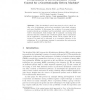Free Online Productivity Tools
i2Speak
i2Symbol
i2OCR
iTex2Img
iWeb2Print
iWeb2Shot
i2Type
iPdf2Split
iPdf2Merge
i2Bopomofo
i2Arabic
i2Style
i2Image
i2PDF
iLatex2Rtf
Sci2ools
107
click to vote
ECAL
2005
Springer
2005
Springer
(Co)Evolution of (De)Centralized Neural Control for a Gravitationally Driven Machine
Using decentralized control structures for robot control can offer a lot of advantages, such as less complexity, better fault tolerance and more flexibility. In this paper the evolution of recurrent artificial neural networks as centralized and decentralized control architectures will be demonstrated. Both designs will be analyzed concerning their structure-function relations and robustness against lesion experiments. As an application, a gravitationally driven robotic system will be introduced. Its task can be allocated to a cooperative behavior of five subsystems. A co-evolutionary strategy for generating five autonomous agents in parallel will be described.
| Added | 27 Jun 2010 |
| Updated | 27 Jun 2010 |
| Type | Conference |
| Year | 2005 |
| Where | ECAL |
| Authors | Steffen Wischmann, Martin Hülse, Frank Pasemann |
Comments (0)

